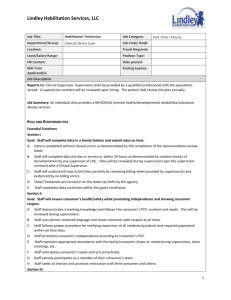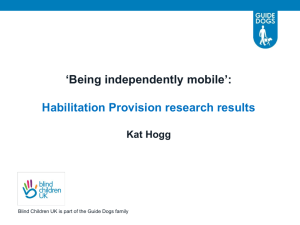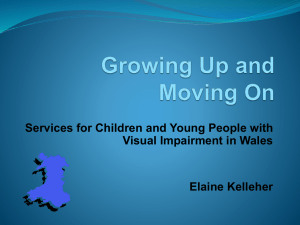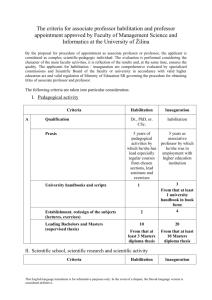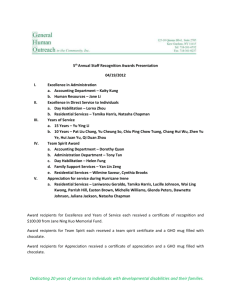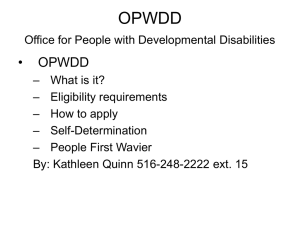Being independently mobile': Habilitation Provision research
advertisement
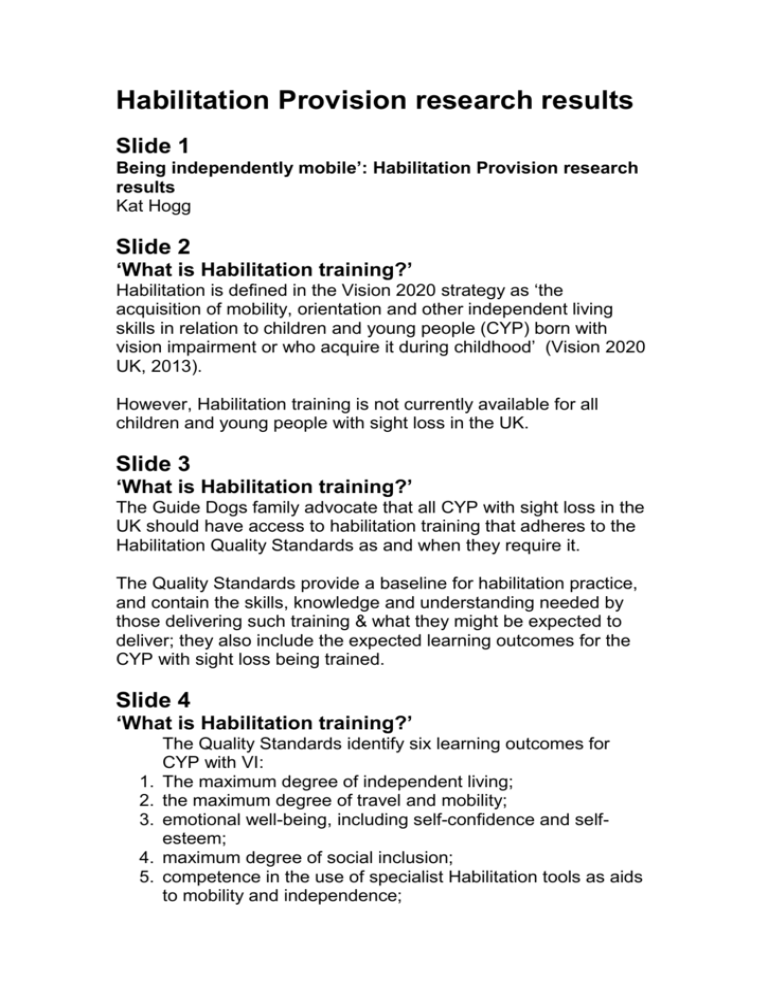
Habilitation Provision research results Slide 1 Being independently mobile’: Habilitation Provision research results Kat Hogg Slide 2 ‘What is Habilitation training?’ Habilitation is defined in the Vision 2020 strategy as ‘the acquisition of mobility, orientation and other independent living skills in relation to children and young people (CYP) born with vision impairment or who acquire it during childhood’ (Vision 2020 UK, 2013). However, Habilitation training is not currently available for all children and young people with sight loss in the UK. Slide 3 ‘What is Habilitation training?’ The Guide Dogs family advocate that all CYP with sight loss in the UK should have access to habilitation training that adheres to the Habilitation Quality Standards as and when they require it. The Quality Standards provide a baseline for habilitation practice, and contain the skills, knowledge and understanding needed by those delivering such training & what they might be expected to deliver; they also include the expected learning outcomes for the CYP with sight loss being trained. Slide 4 ‘What is Habilitation training?’ 1. 2. 3. 4. 5. The Quality Standards identify six learning outcomes for CYP with VI: The maximum degree of independent living; the maximum degree of travel and mobility; emotional well-being, including self-confidence and selfesteem; maximum degree of social inclusion; competence in the use of specialist Habilitation tools as aids to mobility and independence; 6. the ability to be able to assess risk and anticipate likely areas of personal difficulty in mobility and independent living. Slide 5 Habilitation provision research Two projects have been carried out to explore the accessibility and quality of habilitation provision for children and young people with vision impairment (VI) in the UK: Case Studies of habilitation provision: 12 detailed case studies were collected across the UK: England (6) and 2 each in Scotland, Northern Ireland, and Wales; benchmarked against the Quality Standards. Survey work: investigated the Habilitation training experiences of 43 CYP with VI (aged 12-25 years) and 68 parents of CYP with VI (aged 1-18 years). Research outcomes: to inform the ‘Movement Matters’ programme, and to update the Vision 2020 Children and Young People’s group. Slide 6 Habilitation provision research findings There is a lack of clarity of exactly what habilitation is: whether it is a form of education, or a social service. The lack of clarity of exactly what is and who is responsible for delivering its various complements is at the heart of the problems of responsibilities for funding and delivery. Budget cuts: in recent years have impacted negatively on many services and are expected to have further impacts. Eligibility for services: is likely to be tightened in the future as budgets are expected to be cut further, potentially excluding many CYPVI who need services. Variation in service provision: does not appear to be accounted for by devolved national legislation rather, it appeared to reflect decision-making, funding, and service structures at Local Authority (LA) level. Slide 7 Habilitation provision research findings There is considerable variance in the accessibility of habilitation services. Even where high quality habilitation services exist, some CYP still do not access them because there is no systematic provision of information and referral, particularly from medical services, even where CYP meet the criteria for certification and registration. Less emphasis is placed by some local authorities on Independent Living skills training, and outcomes of social inclusion and emotional wellbeing, than on mobility training. The importance of early intervention: The data indicates that if CYP with sight loss are not introduced to mobility training at a young age, they are likely to develop counter-productive strategies and may reject offers of support, training and equipment if training is introduced when they are older. Slide 8 Habilitation provision research findings Habilitation provision for young people post age 16 The case study work reported that one of the greatest gap in habilitation provision lies within the provision of young people post age 16, particularly if leaving education. In some areas there is potential for some of these young people to not have access to any service until they are 18 when they are eligible to access adult services. Slide 9 Habilitation provision research findings Mobility Extent: 41% of young people aged 18 to 25 years were not able to get out and about as much as they would like. Mobility training: Over half of the respondents reported that there were some elements of mobility training that they would have liked to have learnt at an earlier age. The majority of young people stated that they thought that it would be useful for them to have further mobility training. Slide 10 Contact details: Kat Hogg, Research Associate kat.hogg@guidedogs.org.uk
